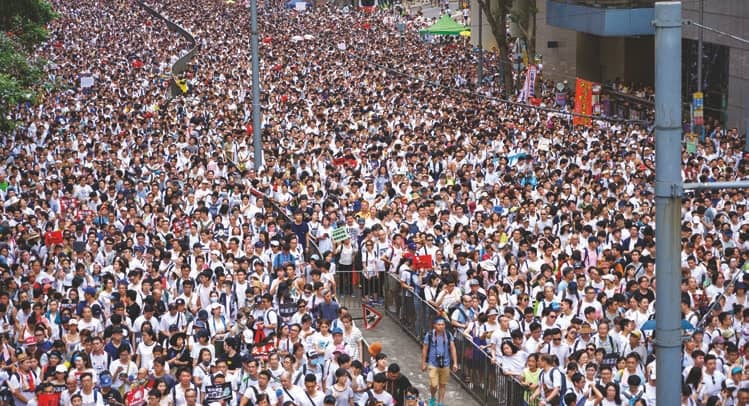Versuchen GOLD - Frei
DEMONSTRATIONS & DEMOCRACY
Faces - The Magazine of People, Places and Cultures for Kids
|September 2020
After six months of demonstrations, blocked streets, and tear gas, Hongkongers peacefully voted in District Council elections on November 24, 2019. Voters—especially young people—wanted to show the leader of Hong Kong’s government, Chief Executive Carrie Lam, how they felt about her handling of the demonstrations.

On the morning of the election, pro-government parties, which supported Ms. Lam and opposed the protests, controlled all 18 of the District Councils. Nearly three million people turned out to vote in Hong Kong’s largest-ever election. When the results were announced, voters stunned the city by flipping control of 17 councils to pro-democracy parties, which opposed Ms. Lam and supported the protests.
Prior to the election, people wondered whether Hongkongers supported or opposed the protests. Over time, the protests disrupted the city in many ways, including the shutting down of public transportation routes and the closing of schools for four days. The District Council election results indicated that citizens were mostly frustrated with the government— not the protesters.
Frustration began building in February 2019 when the government introduced a bill that would allow Hongkongers to be sent to China for criminal trials. The process of sending citizens to other countries for trial is called “extradition,” so the bill became known as the “extradition bill.”

Although Hong Kong is part of China, the city operates under its own legal system. While Hong Kong has a strong and fair justice system, China does not. Hongkongers feared that China would use the extradition bill to force people who opposed the Chinese government to go to China for unfair trials.
Diese Geschichte stammt aus der September 2020-Ausgabe von Faces - The Magazine of People, Places and Cultures for Kids.
Abonnieren Sie Magzter GOLD, um auf Tausende kuratierter Premium-Geschichten und über 9.000 Zeitschriften und Zeitungen zuzugreifen.
Sie sind bereits Abonnent? Anmelden
WEITERE GESCHICHTEN VON Faces - The Magazine of People, Places and Cultures for Kids

Faces - The Magazine of People, Places and Cultures for Kids
Animal Central
From golden frogs to big cats to colorful birds, the national animals of Central America represent the geography and cultures of the region. For a quick sampling of creatures plain and beautiful, common and rare, read on.
3 mins
January 2021

Faces - The Magazine of People, Places and Cultures for Kids
31 Countries Biosphere
The Trifinio Fraternidad Biosphere Reserve is located at a spot where El Salvador, Guatemala, and Honduras converge. A biosphere is the layer of planet Earth where life exists.
2 mins
January 2021

Faces - The Magazine of People, Places and Cultures for Kids
THE LEGEND OF THE QUETZAL BIRD
A Mayan Tale retold by Pat Betteley illustrated by Amanda Shepherd
4 mins
January 2021

Faces - The Magazine of People, Places and Cultures for Kids
Semana Santa GUATEMALA'S HOLY WEEK
What if Easter preparations meant dyeing sand, collecting pine needles, and staying up all night to work on an art project that you knew would be ruined the very next day? Well, welcome to Guatemala’s Semana Santa, or Holy Week.
4 mins
January 2021

Faces - The Magazine of People, Places and Cultures for Kids
ME OH-MAYA!
The Maya are groups of people who live in parts of Mexico, Honduras, and Guatemala. Their ancestors created a great society. At its peak, from 600-900 C.E., the Maya civilization was more advanced than its neighbors in the Americas.
3 mins
January 2021

Faces - The Magazine of People, Places and Cultures for Kids
Playing Games Honduras-style
Would you play the same games in Honduras that you do in the United States? You might. Children in Honduras enjoy many of the same games North Americans do. They go fishing and shoot baskets. They play sandlot baseball—called bate (BAH tay). They fly kites and ride bikes. Their parents may go horseback riding or play golf or tennis.
3 mins
January 2021

Faces - The Magazine of People, Places and Cultures for Kids
LIVING A LONG LIFE IN THE Blue Zone
Most people would like to live as long a life as possible. No one really knows why some people live longer than others, but did you know that where you live can play a big part in how many years you’ll be alive? If you live in a Blue Zone, chances are that you will live much longer than people in other parts of the world.
2 mins
January 2021

Faces - The Magazine of People, Places and Cultures for Kids
ATTENTION WORLD: Belize Saves Their Coral Reef
Sea turtles float in clear waters, colorful corals hug the ocean floor, and aquatic animals glide among the mangrove roots. Welcome to the Belize Barrier Reef Reserve System, the second-largest coral reef in the world (Australia’s Great Barrier Reef is number one). Several years ago, this reef was in crisis, heading toward destruction. But the people of Belize fought back to save their reef’s health.
3 mins
January 2021

Faces - The Magazine of People, Places and Cultures for Kids
The Panama Canal
The Panama Canal is a 51-mile long canal that connects the Atlantic and Pacific oceans.
2 mins
January 2021

Faces - The Magazine of People, Places and Cultures for Kids
This is Central America!
It’s time to visit Central America. But first, it helps to know exactly where Central America is. Despite its name, it is the southernmost part of North America, which can seem a little confusing. It makes up most of the isthmus dividing the Pacific Ocean from the Caribbean Sea. An isthmus is a narrow strip of land that connects two larger landmasses and has water on both sides.
4 mins
January 2021
Translate
Change font size
